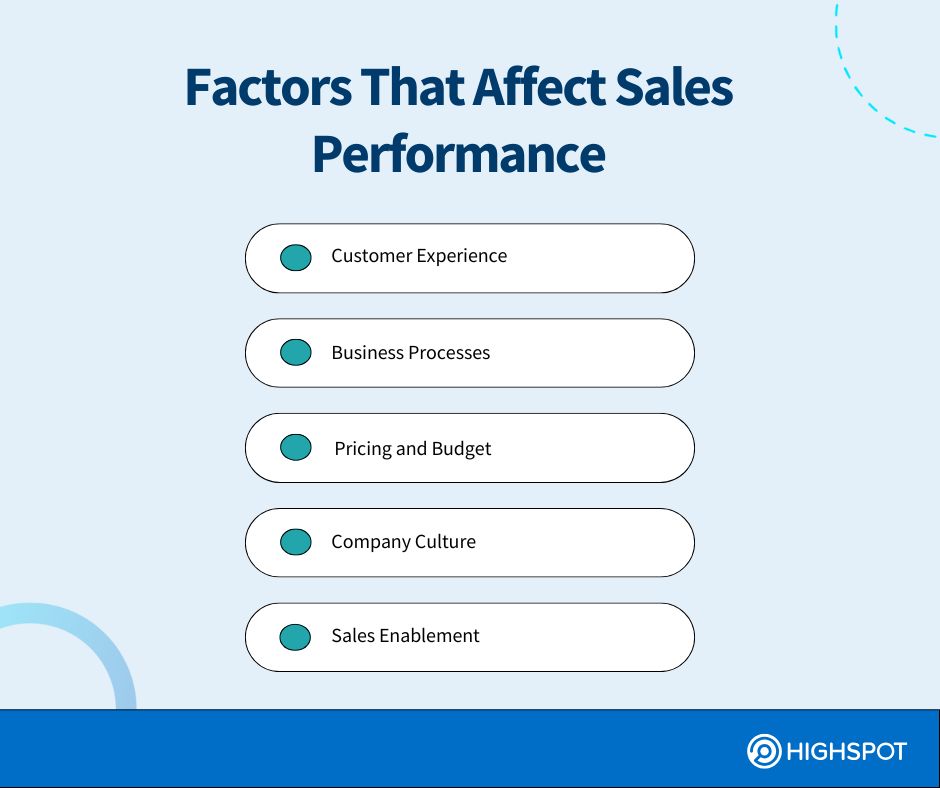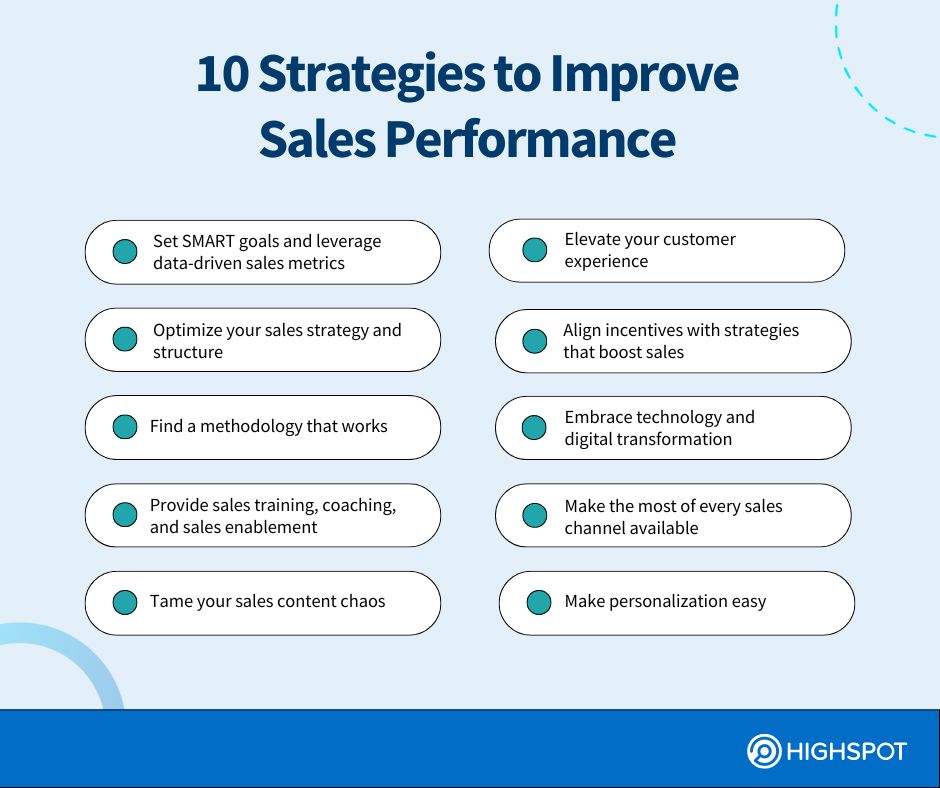Many sales teams put in the hours, follow every playbook, and use every tool at their disposal, yet their efforts don’t seem to pay off. Despite promising leads and solid strategies, deals continue to fall through. It’s a common issue in sales. Hard work doesn’t always translate into results. In fact, leaders reported that 91% failed to hit sales quota expectations this year.
The key lies in refining the approach. Excellent sales performance hinges on meeting customer needs, using data to guide decisions, and continuously enhancing processes.
In this article, we’ll explore improving sales performance, the right tools and technologies, and building relationships. You’ll also find examples of exemplary sales performance and practical tips to help you achieve great results.
Key Takeaways
- Sales performance is impacted by a myriad of factors – there’s no silver bullet to increasing performance
- Focus your efforts on your people. Coach them, train them, and provide them with the tools to be successful
- Be agile with your sales strategy, don’t wait for your yearly SKO to change things up
What Is Sales Performance?
Sales performance refers to how well a sales team delivers results, such as hitting quotas, following up on leads, and converting prospects into customers. Final numbers matter, but it’s also about the how. Are sales reps following processes? Are they building and maintaining strong customer relationships?
How to Measure Sales Performance
Metrics like sales revenue, conversion rates, close rate, and customer retention are used to measure sales performance. It also involves looking at softer skills like negotiation, communication, and responsiveness.
To effectively measure sales performance, you need to track a combination of both quantitative outcomes and qualitative efforts. Many organizations leverage sales enablement software to gain valuable insights into how the team is using resources, engaging with prospects, and closing deals.
What Does Good Sales Performance Look Like?
Effective sales performance can look slightly different depending on the company, but at its core, it’s about sales reps consistently hitting their targets. Many believe that pipeline health is a strong indicator of performance. Having 3-4x your quota in the pipeline suggests ample opportunity to meet targets. However, if sales reps aren’t using good sales techniques, that pipeline won’t translate into closed deals.
The most significant indicator of sales performance often boils down to how much time reps spend with buyers. High-performing reps usually dedicate more time to direct interaction with prospects—about an extra hour per week compared to their peers. That may not sound like much, but it adds up to four additional hours a month, making a considerable difference in sales outcomes.
There are a few benchmarks to consider when tracking sales performance. One example is the number of touches it takes to reach a prospect. On average, engaging a potential buyer takes more than 12 attempts. This stat shows how persistent sales professionals need to be. Additionally, research from the Sales Benchmark Index highlights that 70% of buyers now prefer to work digitally, meaning your team’s digital sales strategy is more important than ever.
When tracking your team’s performance, a good benchmark for lead-to-opportunity conversion is around 30%. Remember, 70% of leads won’t go anywhere, which is normal. The goal is to ensure those 30% are well worth the effort.
Factors That Affect a Sales Team’s Performance
Sales performance is impacted by many factors, from industry disruptions to poor processes and lack of skills. However, the biggest obstacle is that sales reps spend nearly 28% of their week on non-selling tasks like admin work and meetings. That time could be spent face-to-face with prospects.
Here’s a closer look at the factors that affect sales performance:

Customer Experience
If your customer experience is weak, it will hurt your sales performance. Are your sales reps communicating clearly, and are handoffs between teams seamless? Even minor breakdowns in communication can lose a sale.
McKinsey found that brands that can improve the customer journey see revenues increase as much as 10 to 15% while lowering the service cost by 15 to 20%. Your sales process should be smooth for both the rep and the buyer, or it’ll cost you.
Business Processes
Sales performance is often a casualty of poor business processes. Too many approval layers, communication breakdown, and unnecessary bottlenecks can stop a sale dead in its tracks. These inefficiencies can make it seem like a sales team is not performing when the real issue lies with the process.
For example, imagine a sales rep consistently getting buyers excited about the product and ready to close. However, every deal stalls because pricing approval requires multiple sign-offs from sales leaders, finance, CRO, and CEO. The delay frustrates prospects, causing them to lose interest or move to a competitor. In this case, it looks like the rep can’t close, but the reality is that the overly complex approval process is wreaking havoc at the final stage.
Pricing and Budget
No matter how skilled a sales rep is, they can’t overcome poor product-market fit or pricing issues on their own. Besides that, many customers object to pricing due to deeper issues. For instance, they might not see the value of your solution compared to cheaper alternatives. They could also be factoring in extra costs like training and maintenance, which lowers the perceived value.
Sometimes, customers face genuine budget constraints, or they could just be looking for a better option. This can stall deals and make it appear that the sales rep isn’t performing. You can help by enabling sales reps with objection handling training. They can highlight ROI or offer flexible pricing models to keep deals moving.
Company Culture
Sales success is a long game—reps need continuous support to stay sharp. For this reason, company culture plays a huge role. Do you offer incentives for outstanding performance? Is there ongoing training and coaching for reps to grow their skills, or are they expected to hit the ground running without much guidance? Research shows that continuously coaching salespeople may result in spending 23% more time selling and 21% less on post-sales tasks.
Furthermore, performance will suffer if your sales team isn’t aligned with marketing, customer success, and other departments. Messaging, resources, and product knowledge should all be in sync to create a seamless experience for both your team members and your customers.
Sales Enablement
Without onboarding, training, and access to relevant resources, sales reps waste time guessing and scrambling for content and support, slowing down the entire sales process. Sales enablement solves this problem by giving the whole team the tools they need in a centralized location. This streamlined approach keeps them from spending time hunting for content and information, one of the biggest roadblocks to sales performance.
10 Strategies to Improve Sales Performance
There isn’t a single strategy that will enhance sales performance across all organizations. However, once your goals, roles, technology, and enablement strategies are in place, you can see significant improvements.
Here are 10 practical ways to boost your sales team’s performance:

1. Set SMART Goals and Leverage Data-Driven Sales Metrics
Set SMART goals (Specific, Measurable, Achievable, Relevant, and Time-bound) for your sales team to give them a clear direction and a way to measure their success. This will allow reps to see their progress and understand exactly what is expected.
One SMART goal related to sales performance might be to increase sales quota attainment by 10% within the next quarter. This goal is:
- Specific: Focuses on quota attainment
- Measurable: It has a quantifiable target (10% increase)
- Achievable: Based on past performance, it’s within reach
- Relevant: Tied directly to sales performance
- Time-bound: It has a deadline of the next quarter
Once SMART goals are in place, tracking key performance indicators (KPIs) to monitor progress is important. This may include:
- Win rate: The percentage of deals closed compared to deals lost
- Sales pipeline coverage: The ratio of open opportunities to the sales quota
- Conversion rates: Tracks leads to customers.
- Sales cycle length: Measures how long it takes to close deals.
- Average deal size: The average value of your company’s sales transactions or deals.
- Customer acquisition cost (CAC): The costs your business spends on a new customer
Tracking these sales performance metrics alongside the SMART goals and sales forecasts provides a clear view of how the sales reps are doing daily, week-to-week, monthly, or quarterly. For instance, if your win rate is low, you may need to provide more personalized training to your sales reps or adjust your lead qualification process. Regularly reviewing goals and monitoring sales performance data keeps your team on track while flagging improvement opportunities.
2. Optimize Your Sales Strategy and Structure
A well-defined strategy aligns your sales efforts with your business goals. It clearly defines target markets, valuable selling points, and how to address customer needs. For example, a strong sales strategy might focus on building relationships with complex teams of decision-makers while also leveraging AI and sales data to personalize messaging to specific pain points.
Since you need to be agile and responsive to changing consumer needs, don’t shy away from examining your sales strategy bi-annually, quarterly, and even monthly. Though this may seem intensive, it’s important to continuously confirm your sales plan is still relevant to the market you’re selling to.
A significant part of your strategy is your sales organization’s structure. It plays a huge role in how your team can perform. That’s because certain sales models are better suited to certain types of businesses, selling motions, or solutions. It’s not uncommon for businesses to start with one structure and move to another as their company evolves, so take the time to evaluate the three most common sales models—the assembly line, the island, and the pod—and determine which one is right for your business.
3. Find a Sales Methodology That Works
A robust sales methodology helps reps identify customer needs, provide tailored solutions, and continue to support customers after the sale. Some popular methodologies include SPIN selling, which focuses on asking key questions to diagnose customer pain points, and Challenger Sales, which encourages reps to teach customers something new and challenge their existing approach.
It’s important to regularly evaluate whether your current sales methodology fits your business’s growth and market needs. As your company evolves, so should your approach to selling.
4. Provide Continuous Sales Training, Coaching and Sales Enablement
Setting your salesforce up for success starts with implementing a well-structured onboarding process. This gives them the foundational knowledge, skills, and best practices they need to hit the ground running and accelerates their path to productivity. Ongoing sales training is just as important, as it helps sellers adapt to ever-changing buyer expectations and ensure they stay ahead of industry trends.
Beyond training, providing constructive feedback and tailored sales coaching is crucial for nurturing talent and improving performance. Sales managers should regularly evaluate reps to pinpoint areas where they can refine their approach while also celebrating their wins. This balance of growth and recognition motivates the team to push past obstacles and excel in their roles.
Sales enablement ties everything together, equipping sellers with the content, tools, and resources to do their jobs efficiently. It ensures they focus more on engaging customers instead of wasting time looking for answers, allowing them to be more strategic in their approach and create more meaningful interactions.
5. Tame Your Sales Content Chaos
Sales content should help deals move, but even with the best intentions, managing, organizing, and surfacing the right materials at the right time can be chaotic. On average, sales reps use over 17 pieces of content throughout the sales process. They also spend 40% of their time searching for or creating content. This solution leads to off-brand, off-message, and outdated content, which affects the quality and effectiveness of sales interactions.
Centralizing your sales content makes it easy for sales teams to instantly access the latest and most relevant information they need. With everything at their fingertips, sellers can approach buyers with confidence, armed with the right insights. Regular audits further improve this process by helping you identify overlapping content or outdated materials that should be removed, keeping your library streamlined and effective.
Sales enablement technology can help organize and manage content in one place within your team’s workflow.
6. Elevate Your Customer Experience
A seamless and smooth customer experience, where engagement is effortless from the first contact to purchase and beyond, can boost sales performance and customer satisfaction. If your customers encounter delays, poor follow-ups, or clunky handoffs between teams, they’ll hesitate to buy from you again.
Elevating the entire customer experience requires aligning sales, marketing, customer success, and other revenue-generating teams to deliver consistent, helpful interactions at every touchpoint. A great way to stay connected with your existing customers is by creating a Customer Advisory Board, where they can provide feedback and insights to improve your products and services. Satisfied customers are your best advocates, often referring new business through.
7. Align Incentives with Strategies That Boost Sales
Incentives should help drive sales behaviors that align with your sales goals. This will not only enhance performance and retain top talent but also ensure your team focuses on initiatives that drive revenue growth and profitability.
Focus on rewarding sales activities that sell your high-priority products, break into new markets, or help retain customers. You should also be transparent with sales targets and offer meaningful incentive compensation plans for meeting quotas.
8. Embrace Technology and Digital Transformation
Technology and automation can be a huge asset for your sales team, but only when used wisely. Over a third of employees (37%) report using too many tools to use, and 36% state that working across different tools disrupts sales productivity.
To avoid this, focus on adopting tools that improve their day-to-day workflow, such as sales dashboards and CRMs to manage customer data, or AI-powered platforms that help prioritize prospects or personalize interactions. Ideally, your tools can be integrated with one another to streamline your existing processes, from lead generation to closing deals.
Sometimes, a quick in-person conversation will get the job done faster than navigating a complex system of tools. Keep things streamlined, but don’t bog your team down with too many tools or red tape.
9. Make the Most of Every Sales Channel Available
You never know where your next buyer will be, so take advantage of every sales channel available. This could mean email, text, phone, or social media, tapping into partner sales or attending niche industry events.
As you explore new channels, be sure to provide reps with training, content, and guidance on how to maximize each one. Customizing messaging and content, as well as introducing specific sales plays will ensure your team’s pitches land effectively wherever buyers encounter them.
10. Make Personalization Easy
Personalization is key to buyer engagement, but it can be time-consuming for reps. How can you make it easier? Start by putting yourself in your sales reps’ shoes: with lots of content to share and little time to do it, reps need a simple solution to quickly personalize everything from emails to presentations.
Therefore, enablement teams should focus on preparing foundational content—such as a customer deck—with many pivots for different industries and personas, all in one master asset. Adding templated emails and social content into your enablement solution is another great way to make the personalization process simple for reps looking to quickly distribute thought leadership.
You can also leverage conversational intelligence. It uses AI to tailor messaging, create real-time responses, and recommend relevant content based on buyer preferences and past interactions.
Additionally, digital sales rooms (DSR) take personalization to the next level by providing a curated, interactive digital space where buyers can access content and resources just for them, making sales presentations more engaging. Gartner predicts that 30% of B2B sales cycles will be conducted through DSRs, which will also be utilized to oversee the customer lifecycle.
Drive Better Sales Performance with Highspot
To improve sales performance, you need a mix of solid skills and knowledge, access to the right tools, and the ability to understand customer needs. It’s important to track meaningful metrics while ensuring reps can adapt their methods based on individual prospects. No two customers are the same, and each rep needs the right resources to engage with prospects in a way that works for them.
Highspot helps by providing the tools sales representatives need exactly when they need them. With features like content management, AI, digital sales rooms, and sales playbooks, Highspot ensures that your reps have the support necessary to close deals. By making sales enablement seamless, your team can focus on building relationships and improving overall sales performance.
Request a Highspot demo today.




